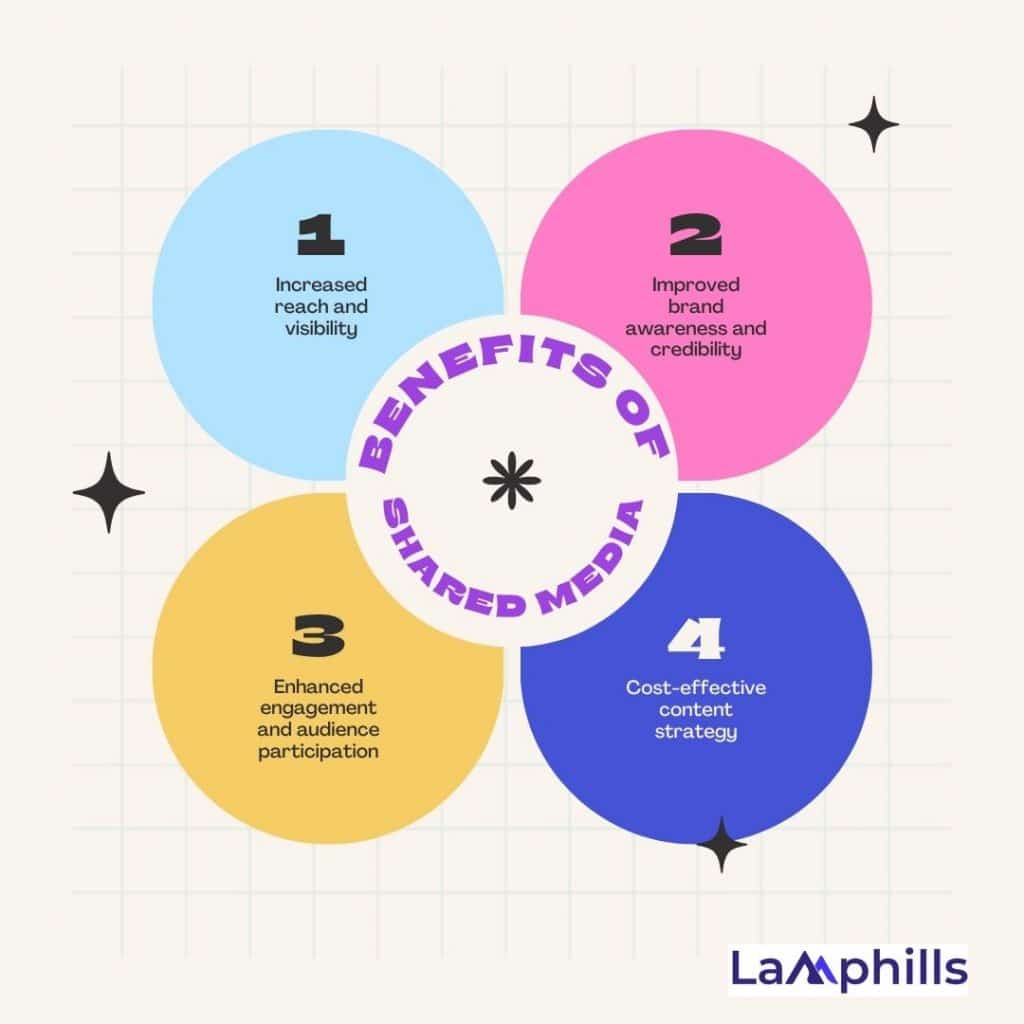In public relations, media refers to any messaging channel or platform the brand might use to connect with customers. Traditionally, there are three types of media: paid, earned, and owned; but a new one has been added recently: shared media. This type of media is quite different from the other ones because it relies heavily on engagement. As the digital landscape keeps expanding, shared media will become an important aspect of any successful content strategy.
I recall a personal experience where shared media made a significant impact on my own content strategy. I was working on a blog post about mental health awareness, and I wanted to make it more relatable and engaging. So, I asked my audience to share their own mental health stories and struggles on social media using a specific hashtag. The response was overwhelming – people shared their stories, struggles, and words of encouragement, creating a sense of community and connection around the topic. The engagement was massive, and the post became one of my most popular ones to date.
Enough of the story already! Let’s get into understanding shared media and how to leverage it for your content marketing strategy.
Key Takeaways
- Shared media is a type of marketing where companies create and share content with their customers and followers on social media. It relies heavily on engagement and interaction with customers, making it different from paid or owned media.
- Shared media can be in the form of user-generated content, collaborative content, syndicated content, and licensed content.
- Channels of shared media include social media, forums, blogs, and email marketing.
- Leveraging shared media leads to increased reach and visibility, improved brand awareness and visibility, enhanced engagement and audience participation, and cost-effective content strategy.
What is Shared Media?
Shared media is a type of marketing where companies create and share content with their customers and followers on social media. This type of marketing relies heavily on engagement and interaction with customers, making it different from paid or owned media. Including shared media in your marketing strategy has a lot of benefits, including increased brand awareness, improved customer relationships, and of course, increased sales! We’ll discuss these benefits in detail going forward, but let’s first see the types of shared media:
Types of Shared Media
Shared media comes in many forms, each with its unique benefits and applications. Here are some of the most common types:
#1. User-generated content (UGC)
This is content created by your audience, such as reviews, testimonials, social media posts, or even videos. I’ve used UGC in some of my blog posts, and it’s added a level of authenticity and credibility to my content.
#2. Collaborative content
This is content created in partnership with other brands, influencers, or creators. I’ve collaborated with other writers and influencers in my niche, and it’s led to some amazing content and new audiences.
#3. Syndicated content
This is content that’s licensed or repurposed from other sources, such as news articles or videos. I’ve used syndicated content in some of my blog posts, and it’s helped me fill content gaps and provide value to my audience.
#4. Licensed content
This is content that’s licensed from other creators or brands, such as stock photos or music.
Read Also: Content Development Best Practices for Higher Engagement
Benefits of Shared Media

Shared media offers a host of benefits that can elevate your content strategy in meaningful ways. Here are just a few:
#1. Increased reach and visibility
When your audience shares your content, it exposes your brand to new eyes and ears, increasing your reach and visibility. I remember when one of my blog posts was shared by an influencer in my niche – it led to a significant spike in website traffic and engagement.
Read Also: How To Measure Reach: Effective Tools and Strategies
#2. Improved brand awareness and credibility
Shared media can help establish your brand as a thought leader in your industry, building trust and credibility with your audience. I’ve noticed that when my audience shares my content, they’re essentially endorsing my brand, which has led to increased loyalty and advocacy.
#3. Enhanced engagement and audience participation
Shared media encourages audience participation, fostering a sense of community and engagement around your content. I saw this firsthand when I asked my audience to share their favourite quotes on social media – it led to a massive engagement and a sense of connection with my audience.
Read Also: Interactive Facebook Posts: Level Up Your Marketing Strategy
#4. Cost-effective content strategy
Shared media can be a cost-effective way to create content, as it leverages the creativity and resources of your audience. I’ve used user-generated content (UGC) in some of my blog posts, and it not only saved me time and resources but also added a unique perspective to my content.
Channels of Shared Media

There are a lot of different ways to use shared media, which include social media, blogs, and even email marketing. Depending on the audience you intend to reach, these channels each have their unique advantages that will be beneficial to your business.
#1. Social Media
Social media is one of the most popular shared media channels, and for good reason. With social media, you can share content with followers and customers in real-time. Thus, you can connect with your customers on a personal level and foster a healthy relationship. Additionally, social media can provide you with a lot of valuable data that you can use to improve your marketing strategy.
#2. Blogs
Blogs are a great way to share content with customers and can be a very effective way to connect with them. By blogging, you can show customers that you are an expert in your field. Blogs also allow customers to leave comments and feedback, so it’ll be a good opportunity for you to improve customer relationships.
#3. Forums
Forums are a great way to connect with customers and get their feedback. They allow you to learn what customers want and need, and how they feel about your products and services. Forums also allow customers to connect with each other, leading to increased brand awareness.
#4. Email Marketing
Email marketing, when done right, can greatly benefit your company. You can email your customers to keep them updated on new product launches, sales, and other important information. With email marketing, you can also track how many people open and click through your emails; thus, improving your marketing strategy.
How to Leverage Shared Media
The part you’ve been waiting for; how can you leverage the power of shared media for your brand? Here are some tips:
#1. Identify your target audience and their needs
Understand what resonates with your audience and create content that speaks to those needs. I’ve learned that my audience loves content that’s relatable, authentic, and engaging.
#2. Develop a content strategy that incorporates shared media
Make shared media a core part of your content strategy, rather than an afterthought. I’ve made shared media a key aspect of my content strategy, and it’s led to some amazing results.
#3. Utilize social media platforms to encourage sharing and collaboration
Use social media to encourage your audience to share their content and collaborate with your brand. I’ve used social media contests and campaigns to incentivize sharing and collaboration.
#4. Measure and analyze the impact of shared media on your brand
Keep track of your shared media efforts and analyze their impact on your brand’s reach, engagement, and credibility. I’ve used analytics tools to track my shared media efforts, and it’s helped me refine my strategy over time.
Best Practices for Shared Media
As with any content strategy, there are best practices to keep in mind when leveraging shared media:
#1. Ensure authenticity and credibility
Make sure the content you share is authentic and credible, reflecting the values and tone of your brand. I recall a time when I shared a post that didn’t quite align with my brand’s values, and it led to a backlash from my audience. Lesson learned!
#2. Use high-quality and engaging content
Share content that’s high-quality, engaging, and relevant to your audience. Avoid sharing low-quality or irrelevant content that could harm your brand’s reputation.
#3. Provide proper attribution and credit
Always give credit where credit is due, attributing shared content to its creators and owners. I make sure to tag and credit the creators of any content I share.
#4. Monitor and moderate shared content
Keep an eye on the content that’s being shared and moderate it to ensure it aligns with your brand’s values and guidelines.
#5. Engage with your audience
Respond to comments, messages, and shares in a timely and authentic manner. I make sure to respond to every comment and message I receive, even if it’s just a simple “thank you.”
Here’s a detailed checklist to help you keep up with these practices:
Read Also: Social Media Etiquette: Best Practices
Other Types Of Media
Owned Media
Owned Media is any content or messaging platform the brand owns or exclusively controls. This may include print media, digital platforms, websites or social media pages, as well as all the content on those channels. Other effective forms of owned media could include white papers, presentations, e-books or other forms of brand-controlled content. Marketing through email, newsletters, or any other direct-to-consumer or direct-to-list operations also falls under owned media, because the brand controls the content being sent.
Paid Media
Paid Media is used when the brand purchases advertising, marketing, or messaging space, whether it’s in print, online, digital or broadcast. This could include anything from PPC advertising to paid mentions in broadcasts, to print or social media advertising. Paid media might also include sponsored posts in publications or blogs, product placement, and anything else in which the brand compensates the media venue for the exposure.
Earned Media
Earned Media is all about getting people talking about the brand. Generally, earned media begins with the PR firm or team having previously established relationships with media personalities or media channels. These relationships give the PR team a direct connection to influencers in the media sphere. Traditionally, earned media is the brand getting mentioned on or in the news, such as a spot on a morning show or a segment on a radio program. Nowadays, that could also mean a similar unpaid promotion on a podcast, blog or website.
Shared Media vs Owned Media vs Earned Media
Shared media refers to social media mentions and recommendations, positive product or service reviews, and direct customer interactions. Because of the variables at play, shared media may be interchanged with owned and earned media. For owned media, when a brand creates content and shares it, it loses control over it. Earned media occurs when brand-created communications are used or promoted on other websites or channels.
The video below elaborates more on the difference between these types of media:
What Is The Difference Between Paid Media and Shared Media?
Paid media involves paid promotion for content, like ads. Shared media refers to content shared by users on social platforms, earned through engagement, shares, and mentions.
What Is Social Media Sharing?
Social media sharing is the act of distributing content (text, images, videos) across social platforms like Facebook, Twitter, Instagram, etc., enabling users to share and engage with information within their networks.
In Conclusion,
Shared media is a powerful tool that every content creator must have. By leveraging the collective energy of your audience, you can create content that resonates, inspires, and drives results. Remember, shared media is about more than just sharing content – it’s about building a community, fostering engagement, and creating something greater than the sum of its parts. So go ahead, share away, and watch the power of shared media transform your content strategy!
Related Articles
- Earned Media Strategy: Proven Tips for Implementation 2024
- Top Paid Media Tips to Explode Your Business Growth
- Media Relations: Everything You Should Know (Updated)
- How to Get Media Coverage for Your Business & Event






